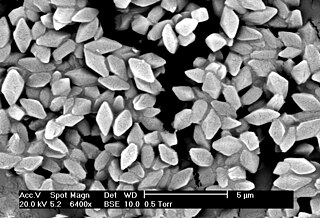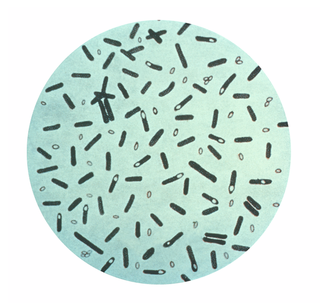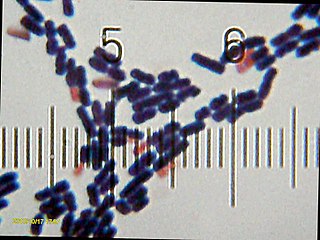Related Research Articles

Bacillus thuringiensis is a Gram-positive, soil-dwelling bacterium, commonly used as a biological pesticide. B. thuringiensis also occurs naturally in the gut of caterpillars of various types of moths and butterflies, as well on leaf surfaces, aquatic environments, animal feces, insect-rich environments, and flour mills and grain-storage facilities. It has also been observed to parasitize other moths such as Cadra calidella—in laboratory experiments working with C. calidella, many of the moths were diseased due to this parasite.

Clostridium is a genus of Gram-positive bacteria. This genus includes several significant human pathogens, including the causative agents of botulism and tetanus. The genus formerly included an important cause of diarrhea, Clostridioides difficile, which was separated after 16S rRNA analysis. They are obligate anaerobes capable of producing endospores. The normal, reproducing cells of Clostridium, called the vegetative form, are rod-shaped, which gives them their name, from the Greek κλωστήρ or spindle. Clostridium endospores have a distinct bowling pin or bottle shape, distinguishing them from other bacterial endospores, which are usually ovoid in shape. Clostridium species inhabit soils and the intestinal tract of animals, including humans. Clostridium is a normal inhabitant of the healthy lower reproductive tract of females.

Alkaliphiles are a class of extremophilic microbes capable of survival in alkaline environments, growing optimally around a pH of 10. These bacteria can be further categorized as obligate alkaliphiles, facultative alkaliphiles and haloalkaliphiles.
Bacillus halodurans is a rod-shaped, Gram-positive, motile and spore-forming bacterium found in soil. In a genomic comparison with Bacillus subtilis, B. halodurans strain C-125 - originally an unclassified Bacillus strain - was found to contain unique genes and sigma factors that may have aided its adaptation to more alkaline environments.
Bacillus clarkii is a facultative anaerobe bacterium. It is a gram positive, alkaliphilic and alkalitolerant, aerobic endospore-forming bacteria.
Bacillus gibsonii is a facultative anaerobe bacterium. It is a gram positive, alkaliphilic and alkalitolerant, aerobic endospore-forming bacteria.
Bacillus halmapalus is a facultative anaerobe bacterium. It is a gram positive, alkaliphilic and alkalitolerant, aerobic endospore-forming bacteria.
Bacillus horikoshii is a facultative anaerobe bacterium. It is a gram positive, alkaliphilic and alkalitolerant, aerobic endospore-forming bacteria.
Bacillus pseudofirmus is a facultative anaerobe bacterium. It is a gram positive, alkaliphilic and alkalitolerant, aerobic endospore-forming bacteria.
Oceanobacillus iheyensis is a bacterium, the type species of its genus. It is a deep-sea species, having been isolated from a depth of 1,050 metres (3,440 ft), and is extremely halotolerant and alkaliphilic. Its type strain is HTE831. Oceanobacillus iheyensis HTE831 is an alkaliphilic and extremely halotolerant Bacillus-related species isolated from deep-sea sediment.
Bacillus horti is a species of Gram-negative alkaliphilic bacillus. Its cells are strictly aerobic rods that produce subterminally located ellipsoidal spores. Its type strain is K13T.
The NhaC family belongs to the Ion Transporter (IT) Superfamily. A representative list of proteins belonging to the NhaC family can be found in the Transporter Classification Database.
Fictibacillus nanhaiensis is a Gram-positive, aerobic, slightly halophilic, facultatively alkaliphilic, rod-shaped, spore-forming snd motile bacterium from the genus of Fictibacillus which has been isolated from an oyster from the Naozhou Island in China.
Fictibacillus solisalsi is a Gram-positive, rod-shaped, halotolerant, alkaliphilic and motile bacterium from the genus of Fictibacillus which has been isolated from saline soil from Shanxi in China.
Halolactibacillus is a Gram-positive, non-spore-forming and motile genus of bacteria from the family of Bacillaceae.
Halolactibacillus halophilus is a non-spore-forming, halophilic and alkaliphilic bacterium from the genus of Halolactibacillus which has been isolated from algae from the Kanagawa Prefecture in Japan.
Salipaludibacillus agaradhaerens is a facultative anaerobe bacterium. It is a gram positive, alkaliphilic and alkalitolerant, aerobic endospore-forming bacteria.
Salipaludibacillus neizhouensis is a Gram-positive, facultatively alkaliphilic, slightly halophilic, endospore-forming, rod-shaped, aerobic and non-motil bacterium from the genus of Salipaludibacillus which has been isolated from a sea anemone from Neizhou Bay from the South China Sea.
Salisediminibacterium locisalis is a Gram-positive moderately halophilic, alkaliphilic, and motile bacterium from the genus of Salisediminibacterium.

Bacillus flexus is an aerobic, Gram-variable, rod-shaped, endospore-forming, oxidase positive bacteria. The endospores are ellipsoidal, located in central/paracentral, unswollen sporangia. In laboratory conditions, it produces opaque, creamish, raised margin colonies at 30 ± 2°C when incubated at 24–72 hrs. on Tryptic Soy Agar (TSA). These bacteria may be isolated from feces (poultry) and soil.
References
- ↑ Nielsen, P.; Fritze, D.; Priest, F. G. (1995). "Phenetic diversity of alkaliphilic Bacillus strains: proposal for nine new species". Microbiology. 141 (7): 1745–1761. doi: 10.1099/13500872-141-7-1745 . ISSN 1350-0872.